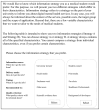Preferences Regarding Information Strategies for Digital Mental Health Interventions Among Medical Students: Discrete Choice Experiment
- PMID: 39365652
- PMCID: PMC11489795
- DOI: 10.2196/55921
Preferences Regarding Information Strategies for Digital Mental Health Interventions Among Medical Students: Discrete Choice Experiment
Abstract
Background: Digital mental health interventions (DMHIs) are capable of closing gaps in the prevention and therapy of common mental disorders. Despite their proven effectiveness and approval for prescription, use rates remain low. The reasons include a lack of familiarity and knowledge as well as lasting concerns. Medical students were shown to have a comparatively higher risk for common mental disorders and are thus an important target group for raising awareness about DMHIs. At best, knowledge is already imparted during medical school using context-sensitive information strategies. Yet, little is known about medical students' information preferences regarding DMHIs.
Objective: This study aims to explore information preferences for DMHIs for personal use among medical students in Germany.
Methods: A discrete choice experiment was conducted, which was developed using an exploratory sequential mixed methods research approach. In total, 5 attributes (ie, source, delivery mode, timing, recommendation, and quality criteria), each with 3 to 4 levels, were identified using formative research. Data were analyzed using logistic regression models to estimate preference weights and the relative importance of attributes. To identify subgroups of students varying in information preferences, we additionally performed a latent class analysis.
Results: Of 309 participants, 231 (74.8%) with reliable data were included in the main analysis (women: 217/309, 70.2%; age: mean 24.1, SD 4.0 y). Overall, the conditional logit model revealed that medical students preferred to receive information about DMHIs from the student council and favored being informed via social media early (ie, during their preclinic phase or their freshman week). Recommendations from other students or health professionals were preferred over recommendations from other users or no recommendations at all. Information about the scientific evidence base was the preferred quality criterion. Overall, the timing of information was the most relevant attribute (32.6%). Latent class analysis revealed 2 distinct subgroups. Class 1 preferred to receive extensive information about DMHIs in a seminar, while class 2 wanted to be informed digitally (via email or social media) and as early as possible in their studies.
Conclusions: Medical students reported specific needs and preferences regarding DMHI information provided in medical school. Overall, the timing of information (early in medical education) was considered more important than the information source or delivery mode, which should be prioritized by decision makers (eg, members of faculties of medicine, universities, and ministries of education). Study findings suggest general and subgroup-specific information strategies, which could be implemented in a stepped approach. Easily accessible digital information may promote students' interest in DMHIs in the first step that might lead to further information-seeking behavior and the attendance of seminars about DMHIs in the second step.
Keywords: digital mental health; health information; innovation diffusion; medical students; preferences; technology acceptance.
©Markus Vomhof, Jessica Tabea Bau, Pia Hüter, Stefan Stehl, Burkhard Haastert, Adrian Loerbroks, Andrea Icks, Stella Teresa Calo, Luca Schuster, Claudia R Pischke, Nadja Kairies-Schwarz, Peter Angerer, Jennifer Apolinário-Hagen. Originally published in JMIR Formative Research (https://formative.jmir.org), 04.10.2024.
Conflict of interest statement
Conflicts of Interest: None declared.
Figures
References
-
- Borghouts J, Eikey E, Mark G, De Leon C, Schueller SM, Schneider M, Stadnick N, Zheng K, Mukamel D, Sorkin DH. Barriers to and facilitators of user engagement with digital mental health interventions: systematic review. J Med Internet Res. 2021 Mar 24;23(3):e24387. doi: 10.2196/24387. https://www.jmir.org/2021/3/e24387/ v23i3e24387 - DOI - PMC - PubMed
-
- Heinig I, Wittchen HU, Knappe S. Help-seeking behavior and treatment barriers in anxiety disorders: results from a representative german community survey. Community Ment Health J. 2021 Nov;57(8):1505–17. doi: 10.1007/s10597-020-00767-5. https://europepmc.org/abstract/MED/33471256 10.1007/s10597-020-00767-5 - DOI - PMC - PubMed
-
- Tomczyk S, Schmidt S, Muehlan H, Stolzenburg S, Schomerus G. A prospective study on structural and attitudinal barriers to professional help-seeking for currently untreated mental health problems in the community. J Behav Health Serv Res. 2020 Jan;47(1):54–69. doi: 10.1007/s11414-019-09662-8.10.1007/s11414-019-09662-8 - DOI - PubMed
-
- Gaebel W, Lukies R, Kerst A, Stricker J, Zielasek J, Diekmann S, Trost N, Gouzoulis-Mayfrank E, Bonroy B, Cullen K, Desie K, Ewalds Mulliez AP, Gerlinger G, Günther K, Hiemstra HJ, McDaid S, Murphy C, Sander J, Sebbane D, Roelandt JL, Thorpe L, Topolska D, Van Assche E, Van Daele T, Van den Broeck L, Versluis C, Vlijter O. Upscaling e-mental health in Europe: a six-country qualitative analysis and policy recommendations from the eMEN project. Eur Arch Psychiatry Clin Neurosci. 2021 Sep;271(6):1005–16. doi: 10.1007/s00406-020-01133-y.10.1007/s00406-020-01133-y - DOI - PubMed
Publication types
MeSH terms
LinkOut - more resources
Full Text Sources


